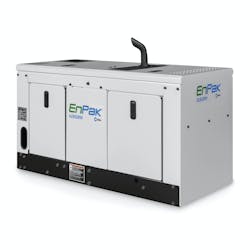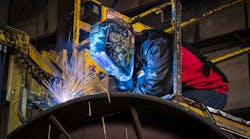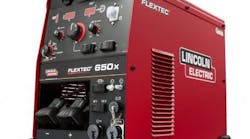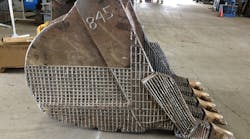The art and skill of attempting to join two pieces of metal together has been part of construction since the Bronze Age when workers used heat and pressure to weld metal. Blacksmiths in the Middle Ages added forges and hammering to the welding process, but it took the Industrial Revolution in the late 1800s and World War I to spur the art of welding to the processes seen today.
Welding trends today are less about hammering and more about increased capabilities, better safety, cost containment, and training more welders to fill the skilled labor shortage.
Mary Ruth Johnsen, 26-year veteran of the American Welding Society and publisher of Welding Journal, says the shortage of experienced welders is driving the new product trends manufacturers are developing. “Welding equipment is getting simpler to operate so that a less experienced operator can get good results. With that are more point-of-use controls, built-in programs with preset weld parameters, semi-automatic and fully automatic processes.” (See "Solving the Skilled Welder Shortage.")
New point-of-control technology is giving welders better control of their time, weld results, and safety. Added capabilities to mobile welding units allow field service trucks to work stronger and lets fleet managers better manage vehicle maintenance and repair costs due to heavy wear and tear. And, for both new and seasoned welders, learning new welding processes with digital support and gaming technology adds more opportunities to stay current in their field.
Here are some trends that will be showcased at Conexpo next month.
More time at the arc point
Wayne Chuko product manager for Lincoln Electric’s CrossLinc products, says the industry has long been asking for a solution to the difficulties operators face when adjustments need to be made at the point of the arc but the power source controls are a distance away from the operator.
“In applications where the welder is in close quarters and cannot fit a welding unit that is the size of a mini-refrigerator into the work area, he has to deal with heavy and expensive cables that carry power and control to the weld point,” Chuko says. “When the operator needs to make changes or adjustments to his process, he has two options: He can put down his work and walk over to the unit, make his adjustments, walk back to the weld point, and start work again. Or he can radio an assistant to make the changes for him. It is an inefficient process in terms of time, productivity, and labor costs.”
Manufacturers are streamlining that process configuration by designing equipment that allows the operator to immediately control his welding parameters at the weld joint.
Single-cable remote systems that eliminate the need for a control cable in addition to the power cable are making set up simpler, improving weld continuity, and increasing safety on construction sites. Fewer cables mean fewer chances for trip and fall accidents, fewer repairs and maintenance costs, and fewer hours spent walking to and from the weld point.
Lincoln Electric’s CrossLinc Remote technology uses a single-cable communications protocol that allows the operator to dial in exact settings at the arc, including voltage on a wire feeder or current for stick welding. Different from other remote controls, CrossLinc controls output on Constant Current (CC) or Constant Voltage (CV) in both DC+ or DC- polarity and displays actual voltage or current while welding. In SMAW mode and DC polarity, the remote uses its mode-sensing capability to reduce arc control to minimum levels for good scratch-start TIG. The welder can choose to display current or voltage during welding, reset the machine back to factory default settings, turn off arc control, and use an arc timer. A digital meter indicates polarity and an LED display indicates if the voltage or amperage display is preset or on actual settings. A memory function will recall where it was set in the event it is disconnected and will power back up at the same settings last used.
The Miller Electric ArcReach family of multiprocess welding systems emphasizes at-hand controls and unit portability. ArcReach Remote technology gives operators the ability to precisely set weld parameters at the wire feeder, then monitor the actual output on digital meters. No extra control cables are required, making portable welding safer and simpler for the operator who finds himself maneuvering around the job site.
Using the Auto-Process Select feature, Miller’s multiprocess system automatically selects the appropriate process based on the polarity detected, reducing the operator’s need to access the power source directly. When the system is turned off, the system will automatically return to the previous power source panel settings.
Continuity and stability create better welds, so when connected to an ArcReach wire feeder, the ArcReach power source overrides and locks out any changes to the weld process, voltage, or amperage at the power source. This remote override ability prevents accidental changes and ensures full weld operator control at the feeder.
More work truck capabilities
“Contractors who use engine-driven welders on service trucks tell us they want less weight, a smaller footprint, and more capabilities,” says John Wasko, segment manager for Lincoln Electric. “‘How many uses can I get out of a tool and how many tools can I get rid of?’ is what we hear.”
Lincoln’s solution is the new heavy-duty 4-in-1 Air Vantage 600 SD Hydraulic Engine-Driven Welder. An integrated hydraulic pump replaces individual truck-mounted pump units and operates independently of a running truck engine.
Wasko says units that weld, power air tools, and offer auxiliary power have been on the market for 15 years, but the Air Vantage 600 has a fourth capacity for the contractor’s work truck. “Contractors can use the onboard pump to run hydraulic-powered equipment, such as truck-mounted booms, truck levelers, clamping fixtures: tools to lift or place objects into position.”
The hydraulic pump operates on its own turbo-charged Deutz diesel engine, eliminating the need to run the truck’s engine during operation. It combines a 600-amp welder, 20,000-watt continuous AC generator, 100-psi air compressor, and 10-gpm Parker Hannifan hydraulic pump.
Because the pump is operated independently, the truck uses less fuel and reduces emissions. Less wear on the truck’s engine prolongs the engine’s life and reduces maintenance costs. “One of our customers told us his company typically runs their trucks up to 90 hours a week. By not having the truck’s engine running to power equipment, the customer said he lengthens the intervals between engine overalls, saving him $65,000,” says Wasko.
Miller Electric says that the emissions-compliant engines used in today’s field service trucks are designed to haul and transport, not be the primary power source for multiple tools.
The EnPak A28GBW all-in-one work truck solution is designed to take the workload off the truck’s engine by providing job site power with an independent 24.8-horsepower Kohler gasoline engine. By freeing the work truck’s engine from the hard work, Miller estimates their EnPak systems cut idle time by up to 50 percent, use 30 percent less fuel, and cut truck engine hours by 36 percent. And because the EnPak unit creates its own power, truck maintenance and repair costs drop dramatically.
The A28 supports metal fabrication and welding repairs with a 210-amp stick welder. Its rotary-screw design, 28-cfm continuous air output will power industrial-strength air tools. The unit delivers up to 100 DC amps of battery charging capability and 300 DC amps for crank assistance. It also powers job site tools and lights with 6,000 watts of AC power, and operates truck mounted electric/hydraulic cranes. The A28 unit can cut the truck’s weight by up to 300 pounds because the vehicle carries fewer power sources. The A28 all-in-one unit has a remote panel with simple, straightforward controls, so crew members don’t need to climb into the truck bed.





